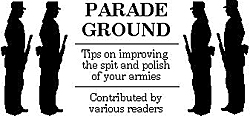 Have you ever looked at some of the miniatures at conventions and wondered, "Why don't my minis look that good?" On closer inspection, you realize it isn't the paint job, but the BASES that look so great. How do they do that? It's not as hard as you think.
Have you ever looked at some of the miniatures at conventions and wondered, "Why don't my minis look that good?" On closer inspection, you realize it isn't the paint job, but the BASES that look so great. How do they do that? It's not as hard as you think.
My current miniatures obsession is painting and basing 15mm infantry and armor for Battleground World War II. As many of you are no doubt aware, 15mm miniatures usually need some support. So, in order to give each infantryman some support, I glued him to a small piece of plastic card stock. Good, now they will stand up on their own. Problem: The plastic base looks cruddy and amateurish. What to do about it? Well, I could paint them green, or brownish, or flock them. In my mind's eye, I could already visualize what that would look like and I didn't like it. What I did was build up fake "soil" around the bases of the miniatures to flock.
How did I do it? Here's the technique:
First you will need the following:
- Some spackle or water based wood putty. I use Elmer's Wood Putty.
Some clean, sifted sand for texture.
A dish or jar to mix in. Old butter or margarine tubs work great for this kind of thing.
Some acrylic paints. Browns and greens are the primary ones.
Different types of flock, static grass, foliage, model railroad ballast, and gravel.
A few small tools to push and place the putty around your miniatures bases. Old popsicle sticks and toothpicks work well for this.
I'm assuming you've already glued your miniature(s) down to their base. To start, take some of the spackle or wood putty and mix it in your dish or jar with some of the sand. It should be a little bit gritty and have an even, lumpy texture. Now, mix in the paint color of your choice; I use burnt umber, until the mix looks either earthlike, or turf-like, depending on your color choice. Now, take one of your popsicle sticks or toothpicks and start to spread the mix around the base. For multi-figure stands this might take a little bit of effort. What you want to try and do is bring the mix up as close as possible to the feet of your minis.
At this point I set the base aside to dry. You could flock it right now. I do this sometimes when I add the gravel or ballast stone to make it look more like rubble. After the mix has set, paint a thin layer of Elmer's white glue over the ground and as close as you dare to the feet of the miniatures. You can mix some acrylic paint with the glue to give it a little color of turf or soil, if you like. Flock as you would usually and add some ballast or gravel for some rock effects. Static grass can be added at this point along with small clumps of static foliage for small shrubs or bushes.
One thing that can make the minis really stand out is to not cover the whole ground area with flock. This makes the ground look more battle scarred. One of the benefits of adding paint to the mix earlier is that you don't need to worry about perfect flocking, or what to do if some should rub off. It looks like perfect terra firma! From here seal the bases, or miniatures as you would normally.
One last little detail that I'm going to add is some custom-printed tags for my 15mm American and British infantry. These tags will be glued on the plastic bases and indicate the following information in order: Company, platoon, squad and weapon. It would look like this: A-1-1-M1, meaning the soldier was a member of A company, first platoon, first squad and carried an M1 Garand rifle. This should ease the identification crisis that working with these little guys can cause sometimes.
Back to The Herald 37 Table of Contents
Back to The Herald List of Issues
Back to MagWeb Master Magazine List
© Copyright 2000 by HMGS-GL.
This article appears in MagWeb (Magazine Web) on the Internet World Wide Web. Other military history articles and gaming articles are available at http://www.magweb.com